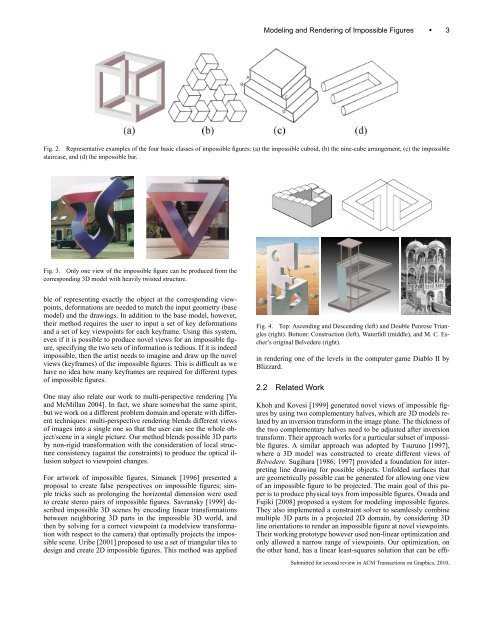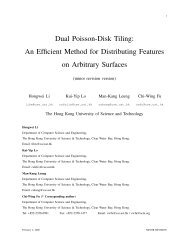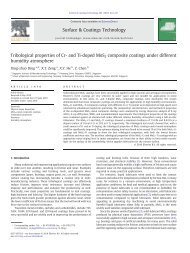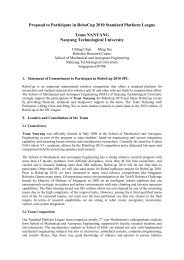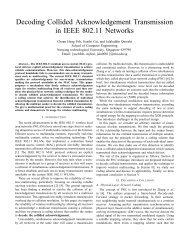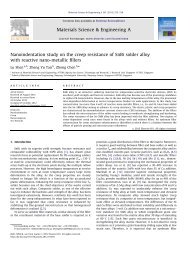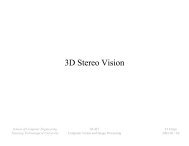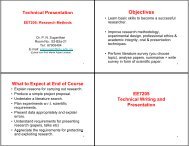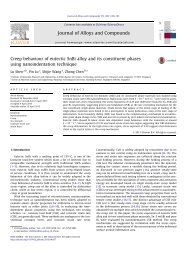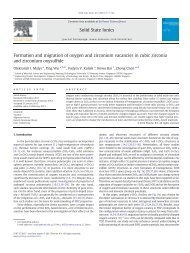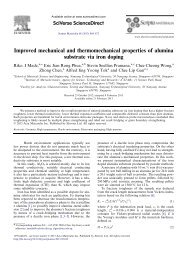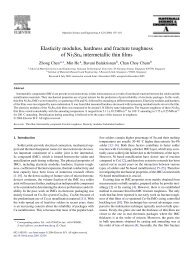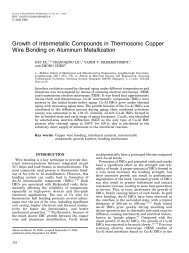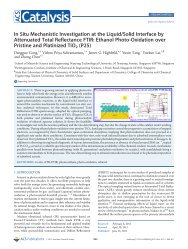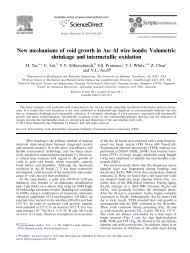ifrender - Nanyang Technological University
ifrender - Nanyang Technological University
ifrender - Nanyang Technological University
Create successful ePaper yourself
Turn your PDF publications into a flip-book with our unique Google optimized e-Paper software.
Modeling and Rendering of Impossible Figures • 3<br />
Fig. 2. Representative examples of the four basic classes of impossible figures: (a) the impossible cuboid, (b) the nine-cube arrangement, (c) the impossible<br />
staircase, and (d) the impossible bar.<br />
Fig. 3. Only one view of the impossible figure can be produced from the<br />
corresponding 3D model with heavily twisted structure.<br />
ble of representing exactly the object at the corresponding viewpoints,<br />
deformations are needed to match the input geometry (base<br />
model) and the drawings. In addition to the base model, however,<br />
their method requires the user to input a set of key deformations<br />
and a set of key viewpoints for each keyframe. Using this system,<br />
even if it is possible to produce novel views for an impossible figure,<br />
specifying the two sets of information is tedious. If it is indeed<br />
impossible, then the artist needs to imagine and draw up the novel<br />
views (keyframes) of the impossible figures. This is difficult as we<br />
have no idea how many keyframes are required for different types<br />
of impossible figures.<br />
One may also relate our work to multi-perspective rendering [Yu<br />
and McMillan 2004]. In fact, we share somewhat the same spirit,<br />
but we work on a different problem domain and operate with different<br />
techniques: multi-perspective rendering blends different views<br />
of images into a single one so that the user can see the whole object/scene<br />
in a single picture. Our method blends possible 3D parts<br />
by non-rigid transformation with the consideration of local structure<br />
consistency (against the constraints) to produce the optical illusion<br />
subject to viewpoint changes.<br />
For artwork of impossible figures, Simanek [1996] presented a<br />
proposal to create false perspectives on impossible figures; simple<br />
tricks such as prolonging the horizontal dimension were used<br />
to create stereo pairs of impossible figures. Savransky [1999] described<br />
impossible 3D scenes by encoding linear transformations<br />
between neighboring 3D parts in the impossible 3D world, and<br />
then by solving for a correct viewpoint (a modelview transformation<br />
with respect to the camera) that optimally projects the impossible<br />
scene. Uribe [2001] proposed to use a set of triangular tiles to<br />
design and create 2D impossible figures. This method was applied<br />
Fig. 4. Top: Ascending and Descending (left) and Double Penrose Triangles<br />
(right). Bottom: Construction (left), Waterfall (middle), and M. C. Escher’s<br />
original Belvedere (right).<br />
in rendering one of the levels in the computer game Diablo II by<br />
Blizzard.<br />
2.2 Related Work<br />
Khoh and Kovesi [1999] generated novel views of impossible figures<br />
by using two complementary halves, which are 3D models related<br />
by an inversion transform in the image plane. The thickness of<br />
the two complementary halves need to be adjusted after inversion<br />
transform. Their approach works for a particular subset of impossible<br />
figures. A similar approach was adopted by Tsuruno [1997],<br />
where a 3D model was constructed to create different views of<br />
Belvedere. Sugihara [1986; 1997] provided a foundation for interpreting<br />
line drawing for possible objects. Unfolded surfaces that<br />
are geometrically possible can be generated for allowing one view<br />
of an impossible figure to be projected. The main goal of this paper<br />
is to produce physical toys from impossible figures. Owada and<br />
Fujiki [2008] proposed a system for modeling impossible figures.<br />
They also implemented a constraint solver to seamlessly combine<br />
multiple 3D parts in a projected 2D domain, by considering 3D<br />
line orientations to render an impossible figure at novel viewpoints.<br />
Their working prototype however used non-linear optimization and<br />
only allowed a narrow range of viewpoints. Our optimization, on<br />
the other hand, has a linear least-squares solution that can be effi-<br />
Submitted for second review in ACM Transactions on Graphics, 2010.


